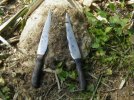Sam Thanks for the order..should ship tomorrow.
in ship time and manufacturing....
but for batch sakes and test purposes
I think I called the first batch of 1.207 dia JDM5160-4/28/05
this last batch of 1.144 dia would be JDM5160-5/22/05
Larry I'm hoping it will all be the same where they are close to each otherNowicki said:Do you think this new batch will act like the last stuff? Are you
going to keep tract of who got which just in case they react diferent?
I'm guessing JD has quality controll on that kind of thing but should we stay on top of it too?
I'll keep mine as JDM5160-batch-1. Haven't forged the second blade yet but so far I'm happy with the first. I was going to do the 2nd one today, with some modifications but spent last night in the ER with mom. We thought it was a heart attack. Turned out to be a toxic reaction to a build up of one of the heart meds she was on They are keeping her for a day or two the reregulate. Some sleep and some yard work and if there is time left I'm going to try the second.
Larry
in ship time and manufacturing....
but for batch sakes and test purposes
I think I called the first batch of 1.207 dia JDM5160-4/28/05
this last batch of 1.144 dia would be JDM5160-5/22/05

